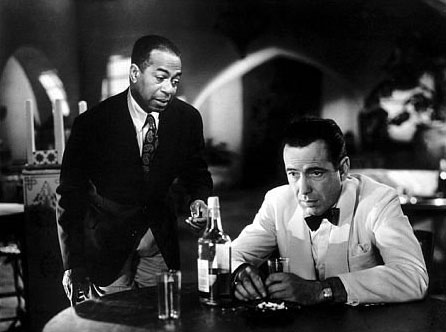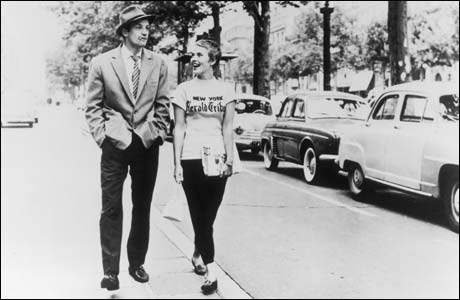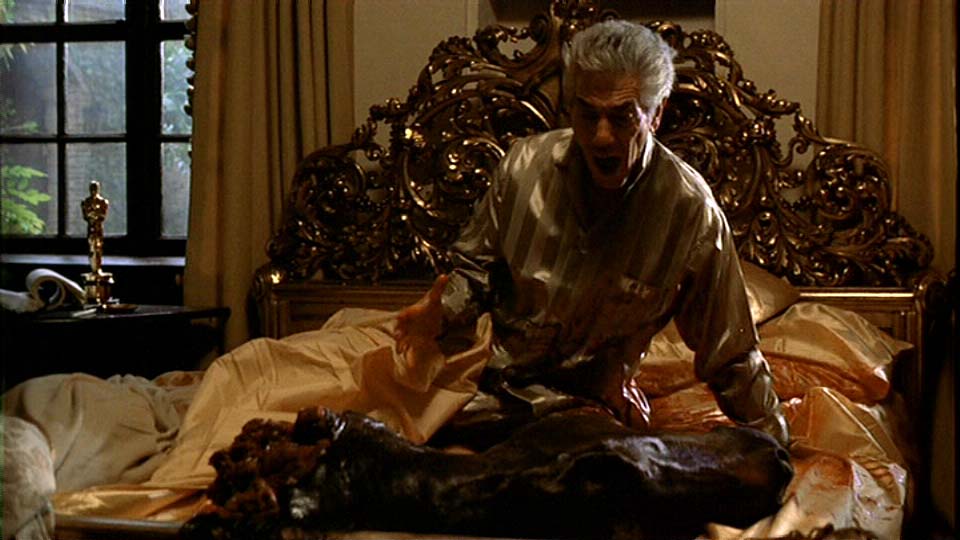There are some good things going on in Daughters of the Dust and then there is the other 107 minutes of the movie. I'll start with the positive and work my way down. The acting was pretty decent. No one was terrible, and this is pretty impressive considering the rest of the movie. Mainly though, the movie as a whole has an idea behind it to work. They feel there is a story to be told. The director isn't working with nothing.
But, so much didn't work about this movie. The music was some of the worst I've ever heard. It was like the makers of Tron made African influenced music. It hurt every moment of the film, and it was in so many unnecessary spots. The cinematography had no cue. The framing of all the shots at first seemed to be doing something. Until I realized that they all just framed the characters in this shaky off center position. It became more of a distraction than art. I have also never been so assaulted by a color scheme. This blue vs yellow theme was shoved down the throat of my eyes over and over and over again. I mean, does the director think they are being artsy by repeating it so much, or do they really think I don't get what they are trying to do? Finally the special effects were pretty terrible. I know, this wasn't exactly a big budget movie, but the special effects were about as good as a bad episode of the X-Files.
So, if I can get past all these technical (for the most part) aspects of the film it wasn't terrible. It tells its story in a different way (though I wouldn't say it's new). That's cool, but I can't do that right? The film was shot more amateurishly than Breathless, and that's saying a lot considering that is the look Breathless is going for. If I just dismissed the problems with all these basic film properties then that would kind destroy what it should be trying to do as film. When a film fails at these basic levels it kind of dismisses itself. Someone laughs at a bad actor cause they sound stupid. Daughters of the Dust is kind of like that. You know they're trying, but so much just isn't working.
Tuesday, November 4, 2008
Wednesday, October 29, 2008
Casablanca

SO...Casablanca, I just don't really like this movie. I mean it's alright, but it's no great masterpiece. I mean, I get it they're mysteriously in love and he decides to fight for something. It just all comes off as being so bland to me. I found myself saying over and over in my head, "Uh, I get it, and it don't care that much." There may be some interesting things in the script. The ideas of Casablanca, America, and Paris, or what drives the changes in these characters. Though, it isn't driven out in the actual film. May be I just found it too generic or I just don't like Humphrey Bogart all that much (gasp!). I just don't see what separates this film from the rest of the pack. I feel like it's more a film of ideas that are never fully realized, but are given a free pass because they are enfolded with Humphrey Bogart.
pic:buzzsugar.com/tags/Casablanca
Raging Bull pt dos
I think the best thing about the editing in Raging Bull is that it's only noticeable when it wants to be, the boxing scenes. The rest of the movie it is "invisible." At least it is as far as I can remember. So this gives the boxing matches a whole different feel. It starts as soon as you get to the stadium or whatever. Like in the title fight, The film stays with the same shot from when he's in the back til he's in the ring. This gives this fight and moment more meaning. The tension created in not changing shots builds in the viewer. Preparing them for the title shot in it's significance to both the story and character. The storyboarding necessary for the actual fights is very evident. The shots' angle, speed, length, and frame are all so precise that they needed the time and attention they must have received. The audience then feels that they are closer to the action because of these deeply detailed sequences. That is the point of these parts. The point is to make the audience feel connected to what is happening to the characters physically and emotionally. The editing helps create the pace, action, and feeling necessary to do this.
Tuesday, October 21, 2008
Raging Bull

Martin Scorsese is probably my favorite director of all time, and Raging Bull is the toughest of Scorsese's films to watch in my opinion. He creates a terrific narative nessesary for telling this harsh story. Jake La Motta is a tragic character from the very beginning of the film making his downward spiral even harder to bare. He's not a character that can be dismissed as a wife beating animal. His other flaws are heaped upon him and the audience over and over until the floor falls breaks beneath it all. His breakdown in the jail cell isn't justice in my mind, but a hard-hitting window into a human who has hit rock bottom. This view is rarely seen with such care and support. This type of hotheaded animal is easily labeled, but Scorsese does more than that. He shows that Jake is a human that can't be defined by a ringname.
pic: profile.myspace.com/index.cfm?fuseaction=user...
breathless

I thought Breathless was an interesting film that does more than its radical editing would suggest. Though it's not perfect, I thought most of the filming was pretty amateur, it's still a good film. I think what interests me the most is its line between what's created as a representation and what is made to be real much like the film Punch-Drunk Love.
To me, both the quick and contrived love between the characters and the bounty against the main character are more of a representation of love and its perils than a direct story. This is created by both in the strangeness in the story and the editing. The story is completely unbelievable. They talk like they really care about each other and love each other, but they've only known one another for a few days. There is also no way that the main character would not have been caught sooner given that his face was plastered all over Paris.
What really sells this idea of love as a representation is the editing. More than anything the editing makes you second guess what is happening over and over again. The disconnect in the story is brought out in the disconnect in the editing. I don't believe that the director just wanted to be different, but I think he was trying to use this editing to enhance his story.
This isn't to say that the whole movie is fake. That is what is great about the movie. Some of the scenes the main characters share together are very real moments. They are out of place from where the viewer sees their relationship, but they are some very truthful moments. They help make this idea of love actually believable.
I don't think Breathless is just an exercise in different editing. I think it takes this radical editing and mixes it with a complicated story to create a film representing love. It isn't something to be taken at face value like people often want. It is something that makes the viewer think about what is really happening and what is being said to them.
Tuesday, September 30, 2008
Da Godfada

It's hard for me to give an exact review of this movie. It's one of my favorite movies, but it's hard to say exactly why. The film has an excellent narrative. Each moment builds upon the last in its own way. There is so much anticipation for Michael to kill Sollozzo, and when Sonny is murdered there is another anticipation whether you know it is going to happen or not. The acting helps this be effective. Everyone in the film does an excellent job with their part. These moments and their development would not work if not for the talent behind the roles. Overall the film is very good, but there is another appeal to me.
For me, I think my love of this film is more personal than anything. I've seen films that have similar qualities as The Godfather, but I don't like them as much. The story has a huge part in why I like this movie. I've always had this obsession with movies about organized crime. The Godfathers, Goodfellas, Casino, and Pulp Fiction are all some of my favorite movies. It has taken me awhile to figure out what really draws me to them. Yes, they're all incredibly well made, but part of me relates to the characters. Not in their violence, but in their pursuit in life. For me, Godfather ends up representing an alternative lifestyle. I think it's a glorification of living outside of society's rules. You don't have to get a real or legitamte job to be successful. I think you can achive your dreams doing something outside of the norm of a typical nine to five office job. That's what the characters in this movie want, and it is apart of their motivation. So yes, it is crucial that the film is well made, but ultimately I'm more drawn to the actions the characters take to live this lifestyle.
pic: movieimage5.tripod.com/
apocalypse now...again
The scene's cinematography that sicks out the most to me is in the Kurtz murder scene. The color for one is huge part of the scene. During the actual murder there is clearly a gold/yellow tint to the shots. I'm not exactly sure what it means. It could be referring to the napalm scene where yellow is used. It also could just be used to draw attention and separation to the scene because it is such an important moment.
The showing of the ox is another interesting choice. It helps go between presence and textuality. There may be a semiotic use for the image of the ox, but it could also be just used aestheticly. Either way it draws the viewer out of the murder for an important spilt second, but then your drawn right back into pressence realizing the brutality. Because the ox murder is so brutal the viewer isn't taken to textuality for the length of the shot. Instead you are pulled for a second, but the then brought right back realizing how gory any killing is. I mean, no one watches that, and isn't emotionally effected on some level.
The moment after Kurtz is killed does a perfect job finishing. Kurtz is shown in incredible focus with low white light, and then it goes to Willard in a different lens less in focus for just a bit. This is a great transition that jars the viewer from the murder. Then Willard is shot in the same lighting that Kurtz had been shot. He stays in this lighting up until he gets on the boat to leave Malasia. There are a number of different ways to read this. It could represent Willard becoming Kurtz for a while, Willard bearing Kurtz's burden of insanity, Willard's own insanity, Willard beating Kurtz at his own game, or Kurtz's blood now being on Willard's hands.
Without a doubt in my mind this murder scene is one the most crucial in the whole movie. The cinematagraphy does a terrific job not only complementing it, but adding it's own pressense to the scene. It brings a needed change in mood. It's what makes the scene really special.
The showing of the ox is another interesting choice. It helps go between presence and textuality. There may be a semiotic use for the image of the ox, but it could also be just used aestheticly. Either way it draws the viewer out of the murder for an important spilt second, but then your drawn right back into pressence realizing the brutality. Because the ox murder is so brutal the viewer isn't taken to textuality for the length of the shot. Instead you are pulled for a second, but the then brought right back realizing how gory any killing is. I mean, no one watches that, and isn't emotionally effected on some level.
The moment after Kurtz is killed does a perfect job finishing. Kurtz is shown in incredible focus with low white light, and then it goes to Willard in a different lens less in focus for just a bit. This is a great transition that jars the viewer from the murder. Then Willard is shot in the same lighting that Kurtz had been shot. He stays in this lighting up until he gets on the boat to leave Malasia. There are a number of different ways to read this. It could represent Willard becoming Kurtz for a while, Willard bearing Kurtz's burden of insanity, Willard's own insanity, Willard beating Kurtz at his own game, or Kurtz's blood now being on Willard's hands.
Without a doubt in my mind this murder scene is one the most crucial in the whole movie. The cinematagraphy does a terrific job not only complementing it, but adding it's own pressense to the scene. It brings a needed change in mood. It's what makes the scene really special.
Subscribe to:
Comments (Atom)